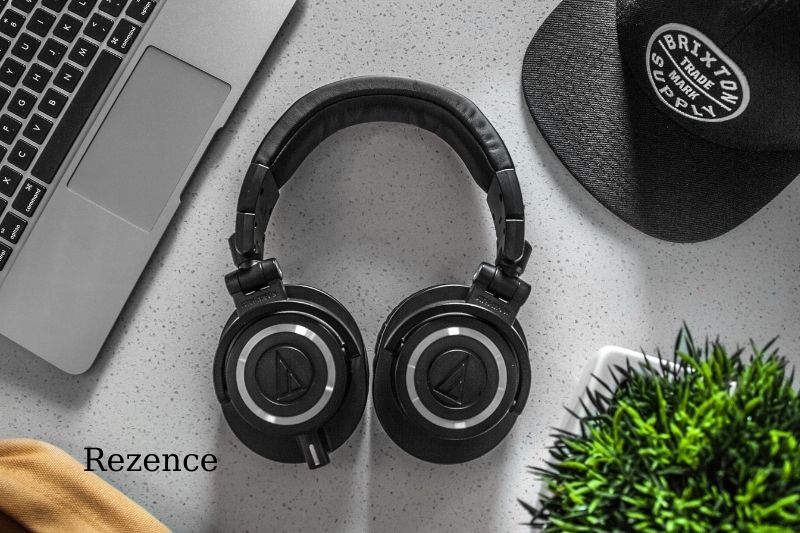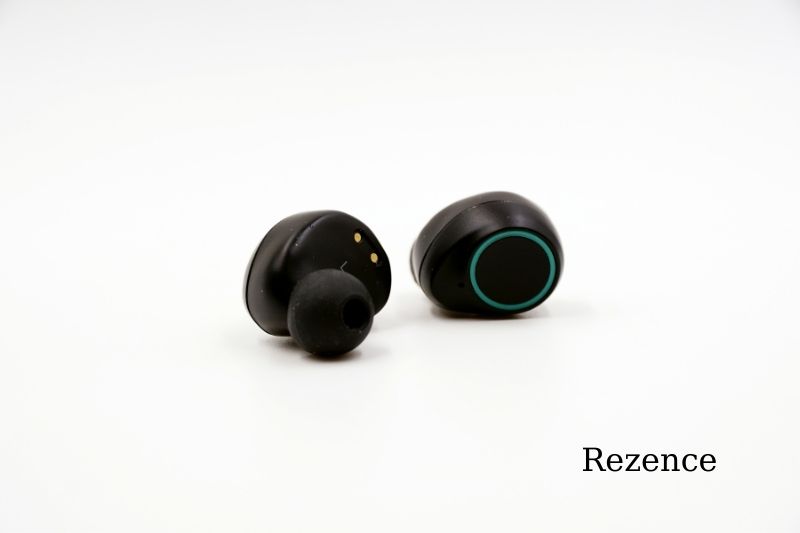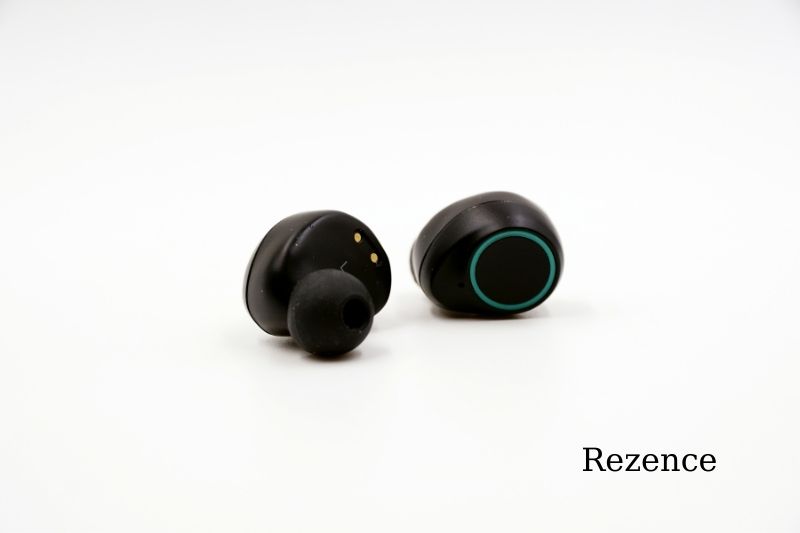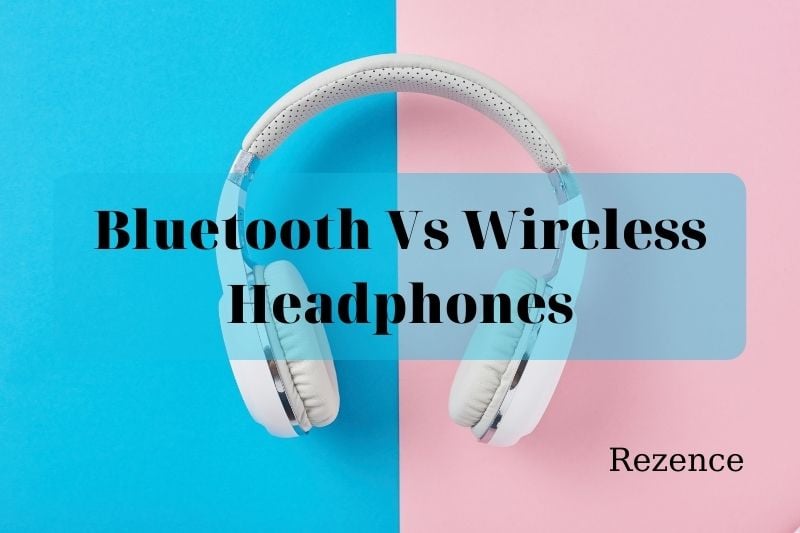In this post, Rezence will go through everything there is to know about the topic.
What Are Wireless Headphones?
You are probably familiar with headphones. They amplify the sound from a media player (e.g. your phone or laptop) and transform it into the wonderful sound you hear.
Wireless headphones eliminate the need for a cable by transmitting sound via low-powered radio waves. Two devices are required to accomplish this process: one device acts as the transmitter (e.g. your smartphone) and the other as the receiver (e.g. your headphones or speakers).
They transmit sound using several technologies, even though the basic concept is the same. Below is more information to help you understand the differences.
Radio-Frequency (RF)
Radio frequency headphones transmit sound using radio waves frequency. To function, RF headphones require a specific transmitter/dongle. Bluetooth is more convenient than this, as it is included in all modern devices.
However, unlike other Bluetooth devices, RF products are able to transmit through walls and solid objects, so signal degradation is almost non-existent. Two things are also possible with RF headsets:
- Superior sound quality
- Much shorter latency (delay)
To maximize immersion, RF headsets often include audio settings such as surround sound or bass boost. Some RF headsets or transmitters allow audio sharing, which is why they are so popular for audio-sharing experiences such as silent disco and watching TV with friends.
The Sennheiser RS120 II wireless headsets offer a great value for money and a high-quality product that can handle virtually all audio content.
Infrared (IR)
Infrared headphones transmit audio signals using infrared signal technology, as the name implies.
They usually come with a docking station to connect to the audio source. Unlike RF headphones, IR transmitters transmit the audio signal using light-emitting diodes instead of radio waves.
They use lightwave technology, so they require a line of sight (LOS) connection between your headphones and the transmitter. They are less likely to interfere with other wireless devices which could affect the sound quality.
Although there are still some models of infrared headphones on the market, they are losing popularity. Wireless headphones offer the best option to travel far away from your audio source. Unfortunately, IR has short-range limitations.
Bluetooth
Bluetooth-enabled chips are the most common feature of wireless headphones. Bluetooth headphones transmit audio signals using a low-powered, 2.4Ghz frequency.
Bluetooth 5.0 offers a respectable range of up to 30m in open areas. This sounds great, but any wall, solid object or other devices that use the same 2.4GHz (like your WiFi or microwave) can impact the Bluetooth connection stability.
Bluetooth devices have unique addresses so they should be identified as separate entities. This way, even though there may be multiple Bluetooth devices in close proximity, your audio source will know which one it wants. Some software can also locate Bluetooth headphones that have been lost.
There are many Bluetooth headphones and earbuds on the market. But the Sony WH1000XM is arguably the most consumer-grade model available.
Kleer
Kleer headphones are equipped with a wireless connection technology that is proprietary to them. It can work in the 2.4GHz, 5.8GHz, and 5.2GHz frequency ranges. Kleer, unlike Bluetooth headphones, only work with the transmitter/dongle included because there are very few audio sources that support it.
They are capable of delivering 16-bit/44.1 kHz lossless/CD quality audio. This means that the sound will not be lost in compression, so you can hear the true quality.
These products have a longer battery life than Bluetooth and are also more efficient at delivering audio. The Sennheiser RS 175 or RS 185 are two models you might be interested in to hear how Kleer headphones sound.
Internal storage
Headphones that have internal storage can be used as both an audio source and receiver independently.
These products often have a micro-SD (or Trans-Flash) memory slot that allows you to listen to music without having to connect to any media players. This allows you to listen without sound degradation or latency.
This wireless headphones implementation can be found in headphones used for swimming and other water-related activities. Wireless headphones connections are affected by water, so Bluetooth, radio frequency waves, and infrared technologies will not be used for watersports activities.
The Sony NW-WS413 is one example of these waterproof headphones.

Related Post:
Wired Vs Wireless Gaming Headset: Which Is Better And Why?
What Are Bluetooth Headphones?
Bluetooth is one of the most remarkable wireless technologies. It works with a limited range but can connect to multiple devices without wires or cables.
Bluetooth headphones allow data to be sent and received using devices like a tablet, smartphone, or laptop. Bluetooth is a feature of these devices.
Bluetooth headphones connect directly with Bluetooth technology, allowing for wireless listening. This technology is found in most modern hi-tech devices, such as smartphones, laptops, and speakers. It usually covers short or limited distances.
You can find Bluetooth radio in small computer chips in Bluetooth devices that allow devices to communicate with one another. As they are often used interchangeably, it is easy to get confused between wireless and Bluetooth headphones.
Bluetooth headphones are wireless and can be connected directly to your phone without the use of wires.
These Bluetooth headphones include the Apple Airpods Pro, Bose SoundSport Wireless, and Sennheiser Momentum True Wireless.

Related Post:
Sennheiser Momentum True Wireless 2 Vs Bose Quietcomfort Earbuds: Which Is Better And Why?
Sennheiser Momentum True Wireless 2 Vs Sony Wf-1000Xm3: Which Is Better And Why?
Difference Between Wireless Vs Bluetooth Headphones
Range Wireless And Bluetooth headphones
The wireless connectivity range is another crucial difference between wireless and Bluetooth headphones.
All Bluetooth headphones have a range of connectivity that can reach up to 30 feet (7-9 meters). Wireless headphones have a range of approximately 300 feet (90m).
However, Bluetooth technology has allowed for an increase in range to about 650 feet (200 metres), and headphones with Bluetooth 5.0 can achieve this range.

Compatibility Wireless And Bluetooth headphones
Bluetooth headphones are superior to wireless headphones in terms of connectivity and compatibility. These are compatible with most Bluetooth-friendly devices. Wireless headphones, on the other hand, are compatible with most machines of the same manufacturer.
Which Is Easier To Use?
The Bluetooth headsets are easy to use because it has a chip that allows you to pair with Bluetooth devices within minutes. On the other hand, wireless headphones come with a USB adapter that establishes a connection between your device and the headphones.
Bluetooth headphones are easier than true wireless devices.
No matter what connectivity type you choose, wireless headphones require that you use the proprietary dongle. You will need to remove the transmitter from the dongle and connect it to the new berth. This is not the most practical method.
Technology Wireless And Bluetooth headphones
Bluetooth headphones directly pair with your smartphone to provide wire-free listening while wireless headphones transmit audio signals via radio waves or infrared.
Bluetooth allows you to send and receive information and data using Bluetooth-enabled mobile devices, such as mobile phones, laptops, tablets, or most Bluetooth-enabled devices.
You can connect Bluetooth headphones to your smartphone via Bluetooth for a wireless listening experience.
True wireless earbuds transmit audio signals via radio frequency waves or infrared. The base connects to the device, a smartphone, speaker, gaming console, or computer. Standard batteries are used to power the headset and can be easily replaced if they run out.
Infrared
It functions exactly like a TV remote. Infrared waves are used to transmit audio signals to the headset via the base unit. Infrared (IR) is optical and has a limited operating range.
To work, the headset must be within a clear line of sight. This limited range can lead to restricted movement. The distance between the transmitter and headset must be no more than 7 meters.
Radio
It works in the same way as a radio but uses radio waves stronger than infrared signals. This makes it possible to walk around your house while wearing headphones.
If the environment is clean and free from obstacles such as cabinets or walls, the range can be up to 300 feet. The range can vary depending on the environment.
Built-in
The important difference between wireless vs Bluetooth headphones is Bluetooth inbuilt in many devices. Wireless headphones will require an adapter to attach to the device. Bluetooth has the added benefit of working across multiple devices and being compatible with smart devices.

Sound Quality Wireless And Bluetooth headphones
This is what sets apart a Bluetooth headset from a wireless headset. While both Bluetooth and wireless headphones use wireless technologies, they don’t use wires or cables.
However, the sound quality can affect the listening experience depending on which device you’re using. Bluetooth headphones indeed sound better than wired ones.
Bluetooth 4.0 technology has made wireless headsets far more reliable than their predecessors. Technology has improved the quality of Bluetooth headphones over time.
Bluetooth has advanced to the point that wireless and true wireless listening is possible. Audio purists will still argue that wired headphones offer better sound quality.
Connectivity And Pairing
Wireless headphones transmit radio frequencies. Bluetooth Headphone uses radio waves for data transmission. It can be paired with any Bluetooth devices.
Stability Of Connection
Although wireless technology is well-established, it has yet to achieve perfect connection stability.
For example, walls, ceilings, and other obstructions that block RF signals are not likely to affect their audio signals. Your connection should be as stable and reliable as possible. However, they are more vulnerable to interference from other devices that emit the same electromagnetic signals.
IR headphones offer better connection stability because they are not affected by radio waves transmissions. However, this comes at the cost of a lower range because of the requirement for line-of-sight.
Bluetooth doesn’t need external transmitters so the stability of Bluetooth depends on your headsets as well as the audio source.
Bluetooth 5.0 has reduced interference with headphones’ audio signals, but older models are still susceptible.
Bluetooth headphones are compatible with older devices, but the features are limited by hardware. Bluetooth 4.0 is only compatible with older 4.0 Bluetooth devices. This means your headphones must support Bluetooth 5.2.
The Bluetooth signal strength decreases as it travels through the air. It is also susceptible to interference from other devices, such as your microwave, WIFI, or even your body.
Top 3 Bluetooth Headphones Available
Bluetooth headphones are becoming more popular, so we selected 10 top-selling Bluetooth headphones and tested them all to narrow down our selection to the best Bluetooth headphones. Below is a summary of what we thought about each pair of headsets.
1. Jabra Elite 85H with Best Design and Sound Clarity
The Jabra Elite85H are excellent straight out of the box. These headphones are much easier to set up than others. They automatically pair with Bluetooth devices without any setup or trouble.
The headphones’ battery life is also worth mentioning. The headphones are able to work up to 36 hours on a single charge thanks to active noise cancellation (ANC). The headphones can be charged to their full capacity in just 5 hours. You can also use them after 15 minutes.
The third aspect is compatibility. The wireless headphones are compatible with Apple, Amazon, and Google Assistants. For phone calls, the microphone quality is superb.
Overall, the Jabra Elite85H are a good choice for their sound quality and design. They are well worth the investment, even though they are a little expensive.
2. Jabra Move Style Edition: The Best Headphones for Budget-Friendly Prices
Jabra Move Style edition Headphones are better than other headphones. These wireless headphones have intuitive controls and are some of the most comfortable headphones available. They are perfect for daily use due to their well-padded headband and soft earpads.
Although the headphones don’t come with ANC, there are many compelling features that make them worth their cost.
3. NAD Viso H70 with the Best Sound Quality
NAD Viso HP70 are among the most impressive on the market. NAD Viso H70 headphones are superior to Jabra Elite 85H, Move Style Edition, and other headphones in terms of sound quality and clarity. Even better: These wireless headphones have ANC functionality.
They are lightweight and easy to set up and use. They are stylish and sleek, but they have poor battery life. However, the sound quality is excellent.
Conclusion
It is crucial to make an informed decision and choose the product that best suits your needs. You can choose to buy either Bluetooth or wireless devices, depending on your preference. Do not buy headsets that “Look good.” It would help if you looked for features like compatibility, range, sound quality, etc. Before you buy a product, consider all aspects.
We hope you found this article useful and could help you make the right decision.

